Best Practices to Run a Shareholder Meeting
Learn how to run successful shareholder meetings that spark impactful conversations.
Shareholder meetings are primarily held to gather shareholders in a neutral environment where voting can take place. In addition to being used for voting on major decisions that will impact the organization, these meetings are also used to review financials and business decisions from the prior year and to plan for the year to come.
Hosting shareholder meetings can seem daunting, but it’s important to remember that it’s just like hosting any other meeting. If you take the time to prepare and create a thorough meeting agenda, you’ll be prepared and able to move forward confidently. Preparation and structure are both key in running an efficient shareholder meeting.
- What are shareholder meetings and why are they necessary?
- How often should you hold shareholder meetings?
- What to include in your meeting invite:
- 10 tips for running efficient shareholder meetings
- Free shareholder meeting agenda:
What are shareholder meetings and why are they necessary?
Shareholder meetings are meetings that occur annually (or more frequently, as needed) amongst shareholders. These meetings are used to elect board members, dive into business reports and financials, and discuss any new initiatives or plans for the upcoming year. These meetings are essential as they’re one of the only opportunities that senior executives and shareholders will have to converse and plan together.

Have an organized discussion
Stay on track and on time during your shareholder meetings by using a meeting agenda to organize the discussion. Try a collaborative tool like Fellow!
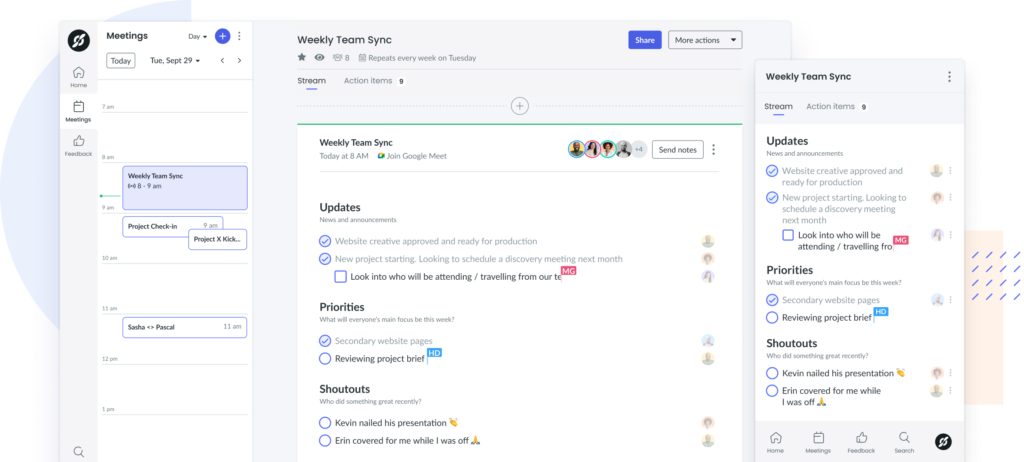
How often should you hold shareholder meetings?
Frequency may vary depending on the needs of your organization, but your business or organization should host at least one shareholder meeting per year.
What to include in your meeting invite:
Meeting invites should be comprised of all legal requirements and any additives you as the host feel are necessary, you should aim to include:
1. The purpose of the meeting.
2. The date, time, and place of the meeting.
3. A notice consisting of any special business that is to be discussed.
4. The nature of any special business that is to be discussed and sufficient details.
5. The text of any special resolution or bylaw that is to be submitted to the meeting.
6. Any additional details required by the by-laws or corporate statues of the corporation.
10 tips for running efficient shareholder meetings
Running successful shareholder meetings is a huge responsibility. Here are 10 tips to make sure your next shareholder meeting is run both professionally and efficiently:
- Send an invitation well in advance
- Keep time zones in mind
- Only invite those that need to attend
- Create a meeting agenda
- Have realistic expectations
- Do introductions
- Begin with the vote
- Show appreciation
- Leave time for a Q&A
- Take meeting minutes and share them as soon as the meeting ends
1 Send an invitation well in advance
Shareholders are busy people with busy schedules, and it’s essential that they make your yearly shareholder meeting. If you want to make sure everyone is able to attend the meeting, you’ll need to send the invitation well in advance. Sending out the invitation and meeting agenda in advance will ensure everyone is prepared and ready to participate in the meeting. You can’t expect attendees to be prepared to participate in the meeting if they aren’t promptly invited and provided with adequate information.
2 Keep time zones in mind
Technology is amazing because it connects teammates, contributors, or even shareholders from all around the world. In a world in which connectivity flows freely, we sometimes forget that not everyone is operating within the same time zone or even on the same schedule. If you plan on hosting a shareholder meeting virtually, make sure to host it during a neutral time that works for everyone.
3 Only invite those that need to attend
A excessively long guest list only leads to confusion. Shareholder meetings are arguably one of the most important meetings that take place within an organization. These meetings are fundamental and lay the groundwork for the upcoming year of operations. When crafting your guest list for this meeting, you should be meticulous and add guests with intent. Make sure you’re only inviting people that need to be there as opposed to just filling the room up with bodies.
4 Create a meeting agenda
We’ve said it before, and we’ll say it again: no agenda, no attenda! Shareholder meetings are essential, and they must follow a predetermined format and be recorded to be accessible to all shareholders. These meetings have organizational and legal requirements, meaning a thorough meeting agenda that takes these components into consideration is imperative.
A thorough meeting agenda will also help ensure nothing is forgotten. It will provide all guests and attendees with a framework that can be used as a tool to move through the meeting with ease. Without a clear agenda, talking points would be forgotten and the conversation would have no structure.
5 Have realistic expectations
Running an effective shareholder meeting is a huge responsibility. You may feel as though you need to cram a year’s worth of content into one meeting, but it’s important to remember that you only have so much time to meet. You have to get clear on your goals and set realistic expectations. You won’t be able to cover everything, so you have to choose the most important talking points and build your meeting agenda from there. If you notice that you aren’t able to fit everything you need into one yearly shareholder meeting, you may need to reevaluate your meeting agenda or even make an executive decision to host more frequent shareholder meetings.
6 Do introductions
Shareholder meetings typically only occur once a year. As a result, it’s customary for those in attendance to not be familiar with each other. Doing a brief introduction before the meeting takes place is also a great way to set a positive tone and build a sense of comradery. This is also a perfect time to go over meeting rules and conduct expectations.
7 Begin with the vote
Every stakeholder reserves the right to vote during stakeholder meetings. Shareholder voting rights give stakeholders the power to elect directors at annual, biannual, or special stakeholder meetings, and they also enable stakeholders to make their voices and opinions heard. These votes are an important element of every shareholder meeting as they ultimately impact the way your organization may function in the future.
This section of the meeting often holds the most contention, which is why we suggest getting it out of the way at the beginning of the shareholder meeting. If attendees aren’t stressing over the vote, they’ll be able to participate in the rest of the meeting with a clear mind.
8 Show appreciation
Stakeholders are often very busy professionals. They have lots of the go—from running other businesses to consulting on panels, mentoring, teaching, or working in their industry. Taking the time to attend a stakeholder meeting is a huge commitment; largely because these meetings take a lot of time and require the stakeholders’ undivided attention.
It’s extremely important that you take the time to express your gratitude and thank everyone in attendance. These stakeholders are involved because they play a fundamental role in your organization. Take the time to show your appreciation for their continued support by thanking them for their contributions.
9 Leave time for a Q&A
Allocating a section of your meeting agenda to cover questions and concerns is imperative. Not only does doing so ensure that everyone has an equal opportunity to ask questions and voice their concerns, but it also ensures the conversation won’t go off the rails after every talking point. Instead of having stakeholders ask their questions after each talking point or section, encourage them to write it down and share it during the Q&A period at the end of the meeting.
10 Take meeting minutes and share them as soon as the meeting ends
Meeting minutes document the most important items that have been discussed during a meeting. They serve multiple purposes, including educating stakeholders that weren’t able to attend and providing context for future action items. Additionally, they serve as a record of discussions for future reference.
Taking thorough meeting minutes is essential, especially during shareholder meetings. Because shareholder meetings only occur once or twice a year, it’s extremely important to record key insights, action items, updates, and talking points. Failing to take thorough meeting minutes may mean that key insights are forgotten or action items aren’t acted upon.
Free shareholder meeting agenda
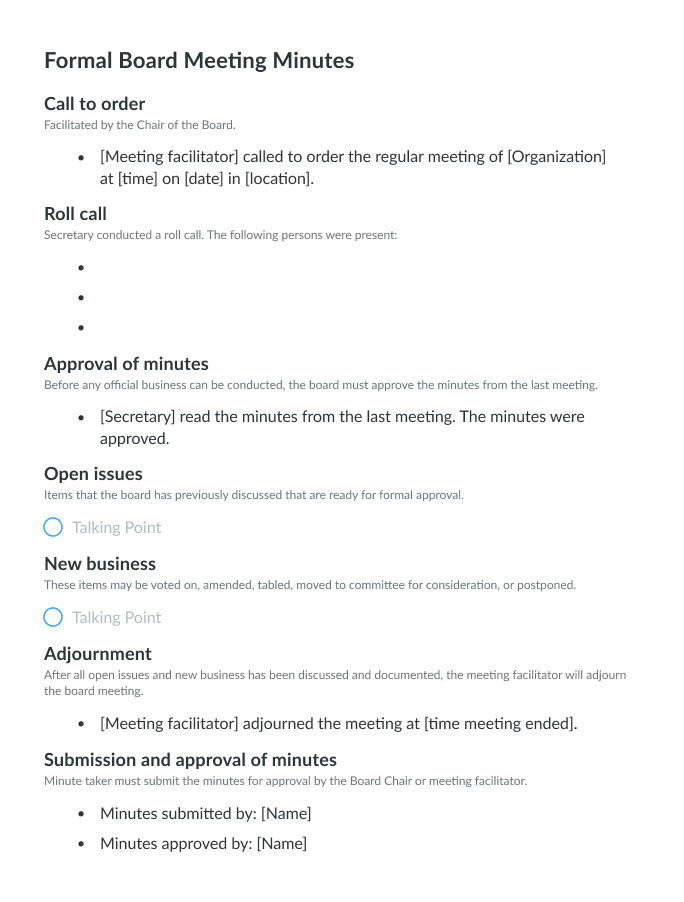
Get ready to host efficient shareholder meetings
Shareholder meetings are arguably one of the most important meetings you’ll ever have the pleasure of hosting. They’re one of the only meetings that require all key stakeholders and executives to gather and discuss the interworking of the corporation together. If you take these tips, tricks, and shareholder meeting templates into consideration when planning for and hosting your next shareholder meeting, you can be sure it will run swimmingly from start to finish.
![How to Run a Delightful AGM [+ Free Template]](https://fellow.app/wp-content/uploads/2022/07/How-to-Run-a-Delightful-AGM-2.jpg)

![Fist-to-Five Voting: How to Foster Efficient Decision-Making [+ Free Template]](https://fellow.app/wp-content/uploads/2022/05/Fist-to-five-voting-2.jpg)




![How to Run an Engaging Sprint Retrospective Meeting [+ Free Templates]](https://fellow.app/wp-content/uploads/2022/02/retro.jpg)

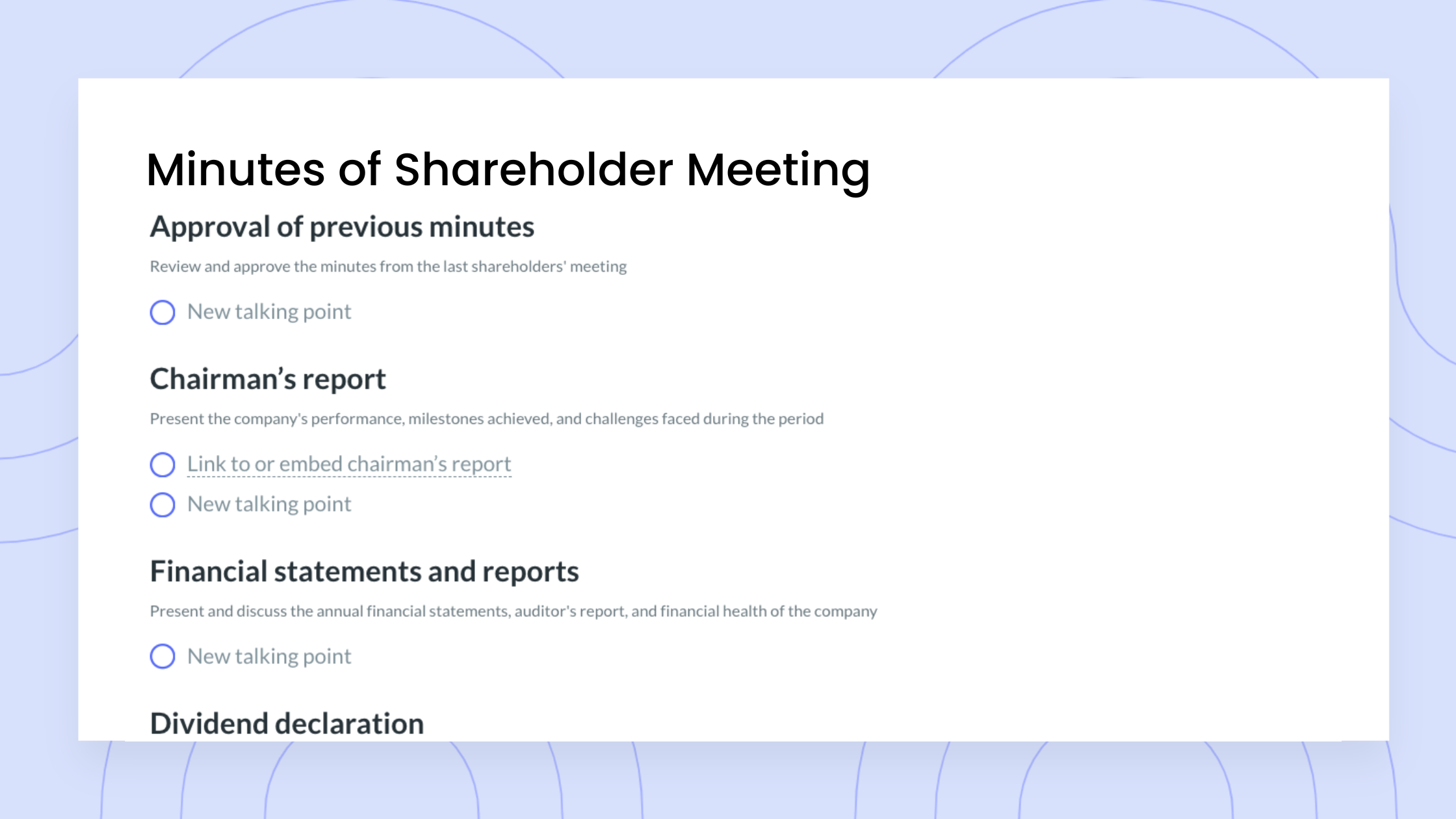
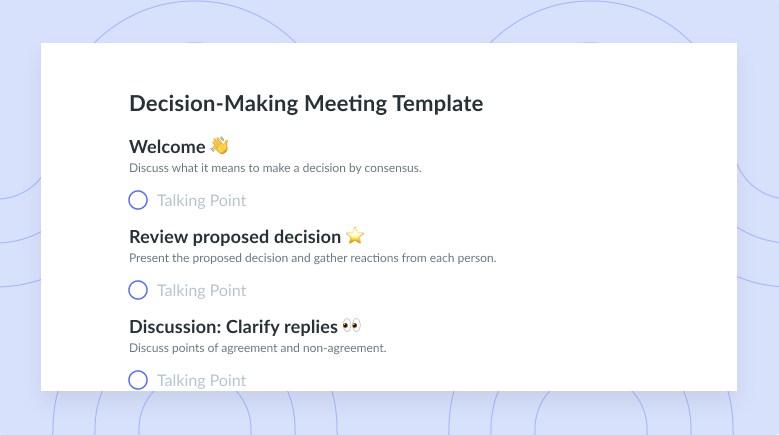
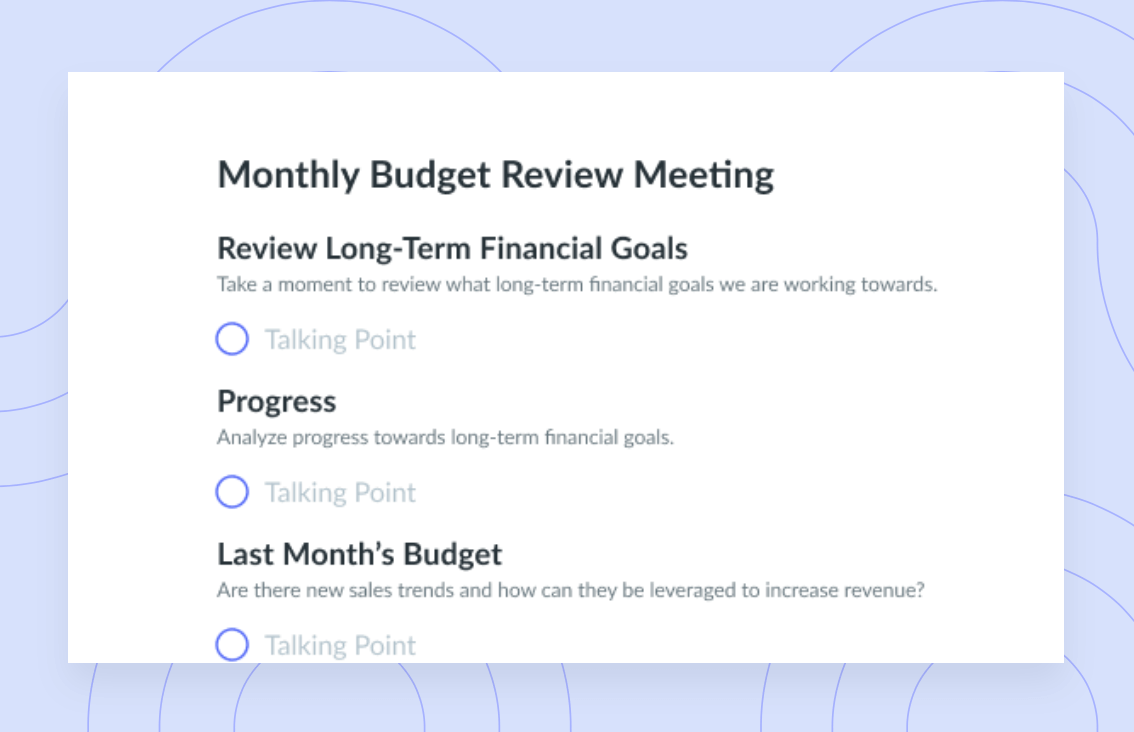

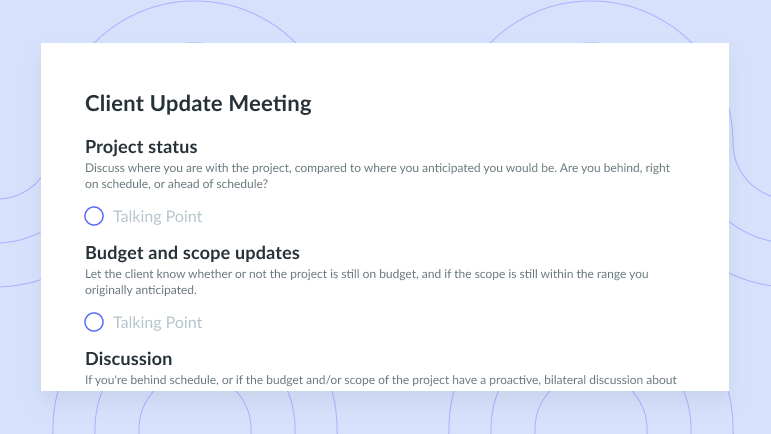
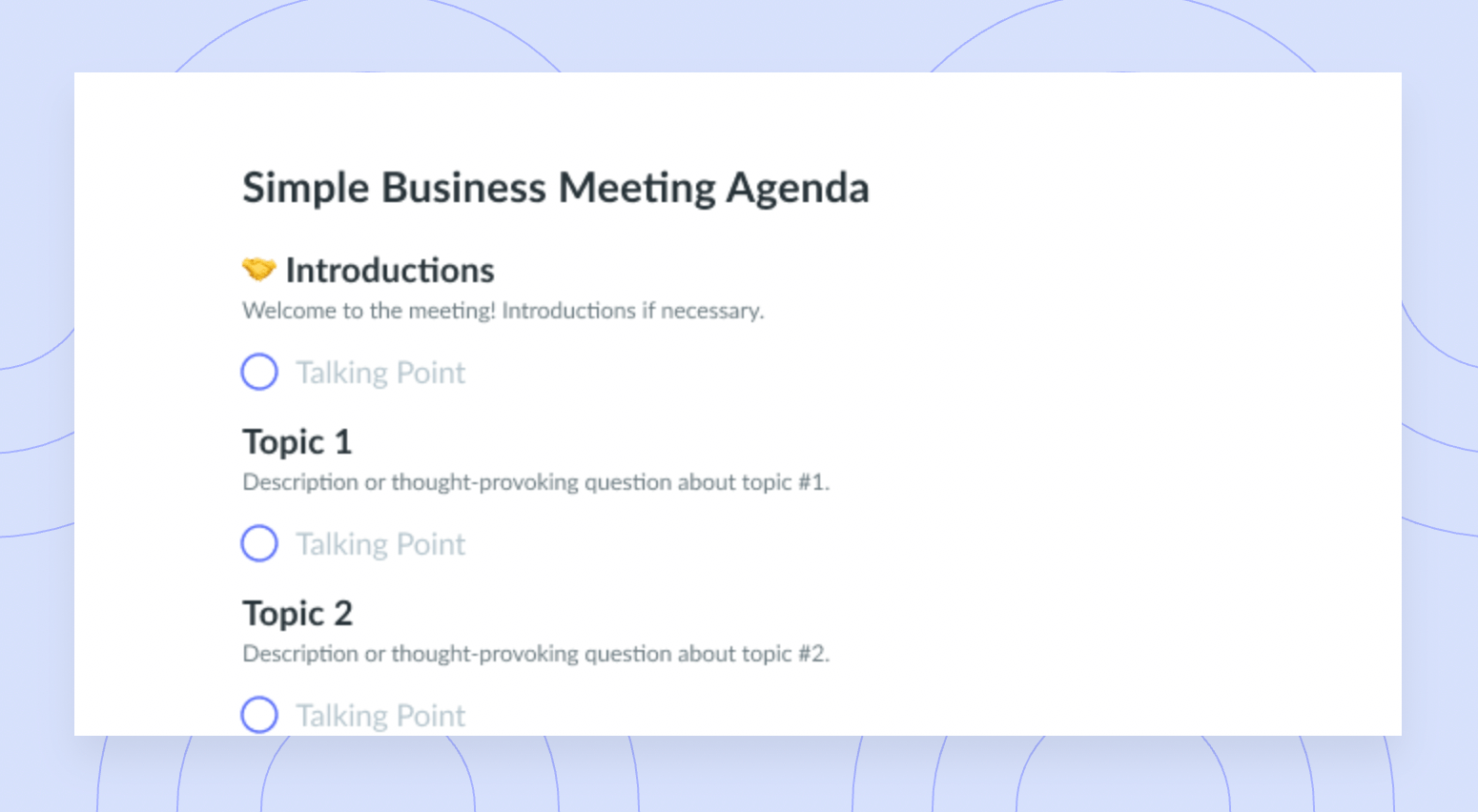
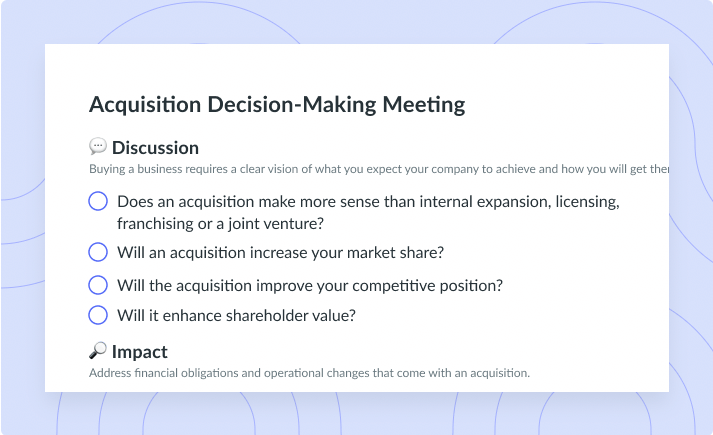

![1-on-1 between CEO and Executive [Lobbyist Association] Template](https://fellow.app/wp-content/uploads/2021/09/1-on-1-between-CEO-and-Executive-Lobbyist-Association-preview.png)










